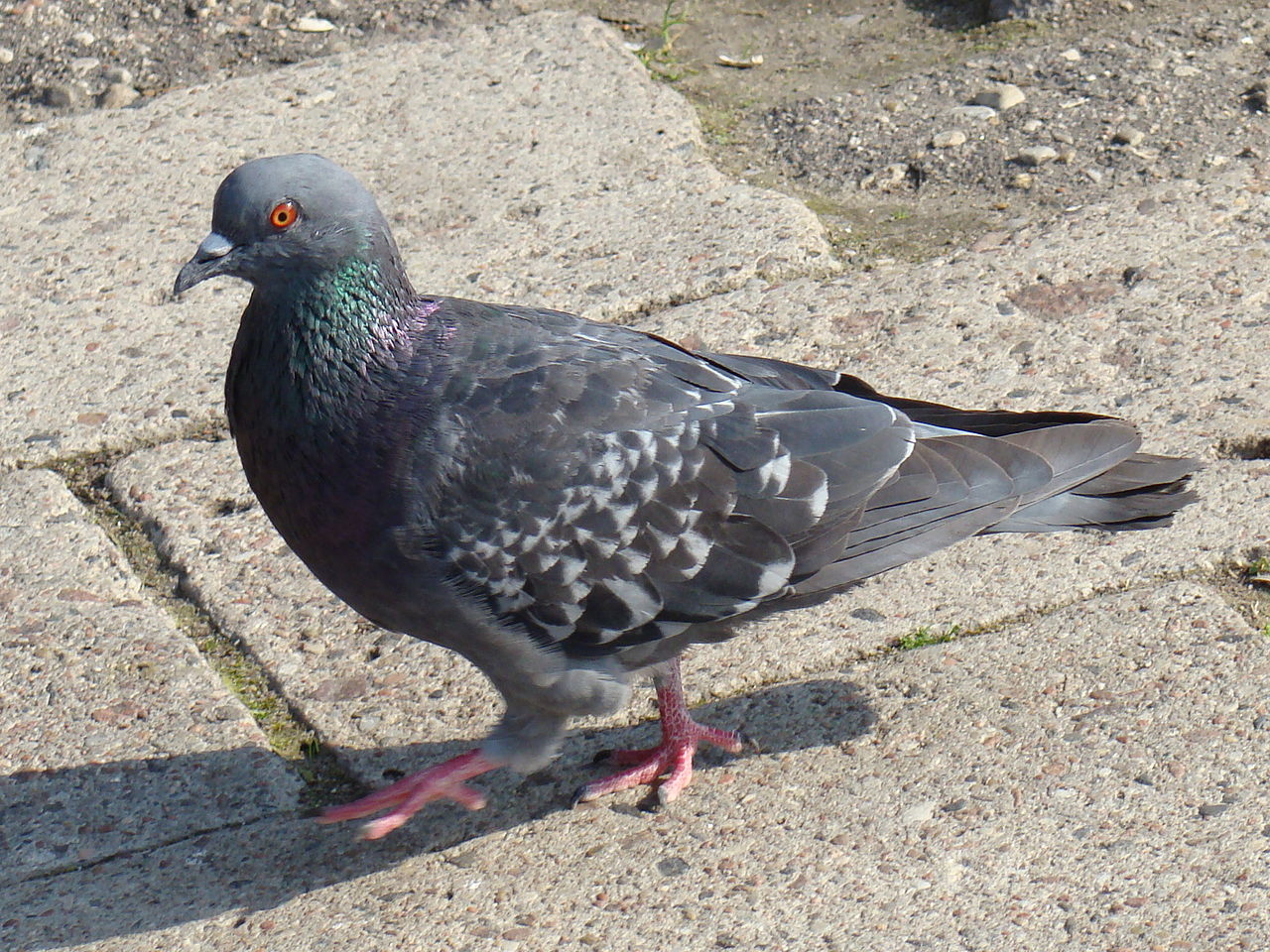Garden Wildlife
Garden Wildlife


Feral pigeon / Rock dove Columba livia
Domestic pigeons, and their escaped relatives feral pigeons, are all descendants of the rock dove Columba livia which is now only found opn remote sea cliffs in the far north and west of Britain and Ireland. Pigeons have been bred here for meat since Roman times, and have been bred for plumage variety and for racing. Escapees interbreeding over many generations has meant the birds are very variable. They seem to be getting more common in gardens, and were recorded in about 15% of gardens surveyed.
What do they look like?
Where do we start! They are much smaller (32 cm) than woodpigeons, and generally grey without their purple breast and white neck patch. Many feral pigeons look a lot like the ancestral rock dove, but some are very different, without the black wing bars, or with black freckling, or practically wholly black or white. See our pigeons page to compare with other species.
What do they sound like?
Feral pigeons have a low crooning or bubbling "oo-roo-coo".






True rock dove (and starlings) on Shetland Feral pigeon close to ancestor in plumage

Examples of the plumage variation in feral pigeons
Peter Ward and Ken Hall, XC613537. Accessible at www.xeno-canto.org/613537.
What do they eat?
Rock doves are ground feeders taking seeds, while feral pigeons are still ground feeders but are very catholic in their tastes. They like kitchen scraps, bread, bird seed, and in cities, discarded fruit, pizza, chips and hot dogs. They iritate some bird lovers by "stealing" from bird tables to the disbenefit of "proper" garden birds.
Herman van der Meer, XC200010. Accessible at www.xeno-canto.org/200010.
How are they doing?
There were estimated to be 465,000 pairs in Britain in 2016. Numbers dropped by about 25% between 2004 and 2017, but seem stable now. Attempts are being made to discourage them from city centres since they can occasionally be vectors of human disease such as histoplasmosis, cryptococcosis and psittacosis, but more from the nuisance factor of their acidic droppings.
Finding out more:
RSPB profile on feral pigeons
BTO profile on feral pigeons
Page written and compiled by Steve Head

What do they do?
Feral pigeons often live and breed communally, which is why they were so easy to rear in dovecots. In cities and towns they have adopted the nearest parallel to sea cliffs for nesting - ledges and roofs on buildings.
In warm, food-rich cities they breed almost continually and they can appear in huge flocks in city centres. The photo shows pigeons in Trafalgar Square in London.
Pigeon feeding is now illegal in Trafalgar Square and around St Martin-in-the-fields in London, which has reduced the size of flocks enormously.
Feral pigeon / Rock dove Columba livia
Domestic pigeons, and their escaped relatives feral pigeons, are all descendants of the rock dove Columba livia which is now only found opn remote sea cliffs in the far north and west of Britain and Ireland. Pigeons have been bred here for meat since Roman times, and have been bred for plumage variety and for racing. Escapees interbreeding over many generations has meant the birds are very variable. They seem to be getting more common in gardens, and were recorded in about 15% of gardens surveyed.


True rock dove (and starlings) on Shetland Feral pigeon like ancestor in plumage





Examples of the plumage variation in feral pigeons
What do they look like?
Where do we start! They are much smaller (32 cm) than woodpigeons, and generally grey without their purple breast and white neck patch. Many feral pigeons look a lot like the ancestral rock dove, but some are very different, without the black wing bars, or with black freckling, or practically wholly black or white. See our pigeons page to compare with other species.
What do they sound like?
Feral pigeons have a low crooning or bubbling "oo-roo-coo".
What do they eat?
Rock doves are ground feeders taking seeds, while feral pigeons are still ground feeders but are very catholic in their tastes. They like kitchen scraps, bread, bird seed, and in cities, discarded fruit, pizza, chips and hot dogs. They iritate some bird lovers by "stealing" from bird tables to the disbenefit of "proper" garden birds.

What do they do?
Feral pigeons often live and breed communally, which is why they were so easy to rear in dovecots. In cities and towns they have adopted the nearest parallel to sea cliffs for nesting - ledges and roofs on buildings.
In warm, food-rich cities they breed almost continually and they can appear in huge flocks in city centres. The photo shows pigeons in Trafalgar Square in London.
Pigeon feeding is now illegal in Trafalgar Square and around St Martin-in-the-fields in London, which has reduced the size of flocks enormously.
How are they doing?
There were estimated to be 465,000 pairs in Britain in 2016. Numbers dropped by about 25% between 2004 and 2017, but seem stable now. Attempts are being made to discourage them from city centres since they can occasionally be vectors of human disease such as histoplasmosis, cryptococcosis and psittacosis, but more from the nuisance factor of their acidic droppings.
Finding out more:
Page written and compiled by Steve Head
























